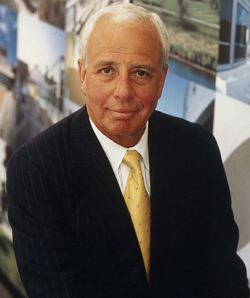Trending
Q & A with W New York Downtown architect Bob Siegel
The Gwathmey Siegel & Associates Architects co-founder speaks about what apartment buildings will look like later this century and what it was like to lose his high school buddy and company co-founder Charles Gwathmey
 Bob Siegel, co-founder of Gwathmey Siegel & Associates Architects
Bob Siegel, co-founder of Gwathmey Siegel & Associates ArchitectsBob Siegel who co-founded Gwathmey Siegel & Associates Architects in 1968, said his staff numbers 40 today, down from 65 two years ago. Plus, a few major projects are winding down, “and there are not a lot of replacements coming in” to the firm’s sole office, in Manhattan, Siegel said.
One recently completed project is the new W Hoboken Hotel and Residence, a 26-story high-rise in New Jersey with 225 rooms and 30 condominium units, while the Financial District’s under-construction W New York Downtown Hotel & Residences, whose 58 stories contain 217 rooms and 159 residences, is set to debut within weeks, though the project has been somewhat troubled: the city has slapped it with 30 stop-work orders, and it’s wrapping up two years behind schedule.
In an interview with The Real Deal, Siegel, 70, spoke about why his favorite New York neighborhood is Battery Park City, what apartment buildings will look like later this century and coping with the death of the firm’s other founder, Charles Gwathmey, last year.
What are your favorite projects in the past few years?
I really enjoy working with schools. We’ve probably done 100 campus buildings and some entire campus plans. Developer projects are market-driven, but when you’re working with schools, they are more rewarding, almost like doing a house. You talk about goals and work through the process. You don’t get that real connection to the user group when you are working on developer projects.
Hostos Community College on the Grand Concourse [in the Bronx, close to where Sigel grew up] was an interesting project. New York is great because you get such a variety of opportunities to make a variety of buildings types, all within the urban fabric of the city. There are all sorts of wonderful and ever-changing contexts here.
What have so many problems seem to beset the W hotel project downtown?
They definitely had delays, but I can’t really speak to that. All I can say is we are thrilled to see that it is finally up and most of the exterior cladding is on. I was never really worried it wouldn’t be built.
Louise Sunshine had been doing the marketing. She was going to be selling the apartments, but then she severed her relationship with [Corcoran Sunshine Group]. At that point, we had completed the design of the interior, but then [Michael] Shvo came in with a different take and brought in a different interiors firm, which redesigned it. What impact that had on the construction of the building I don’t know, but there was definitely an inefficient period.
What do you think of the condo you designed at Astor Place that generated controversy because of its green glass façade and retail base, which houses a bank?
I love it. To talk about it, you have remember there was a parking lot there, surrounded by traditional masonry buildings. But the site was almost like a vector diagram, because you could see it from all these different streets. I thought it was very successful until Paul Goldberger [the New Yorker’s architecture critic] wrote his article, which I thought was unnecessary. I think so many people responded so positively to the building, but it just wasn’t handled very well by the press.
If design in the last boom seemed to be about Modernism, with lots of glass walls, what is the next trend in New York?
What I think will rule are complex digitized forms. Computers have made a huge impression on practicing architects, especially the younger ones. They can create forms that we could never have drawn. When you look around and see some of these uniquely formed buildings… I think that’s a style we will be experiencing for a while.
But what still remains to be seen is how buildings created by computers sit side by side, like in a small town or on a campus, because there is often no common denominator that ties their forms together. Computers are obviously good at making a one-off building. But is this kind of architecture going to Make A Better Street?”
You live in Battery Park City. Why there?
I like Battery Park City because it’s convenient to the office [near the Javits Center] but I also like sailing and waterfront properties. It’s pretty easy to like something that sits along an esplanade and looks out over the water. It’s been beautifully done in many respects, and I feel it’s a logical place to live in New York. But people still come there and are surprised by how good of a neighborhood it is.
What was it like to lose Gwathmey last year?
Well, we knew each other in high school. We played basketball and baseball together, then split for college, but both worked for [the now deceased eminent architect] Edward Larrabee Barnes. You’re talking about a very intense relationship between two guys for 50 years, and we never had any great differences that caused us grief. It’s a huge loss and something that [the firm is] learning how to deal with.




